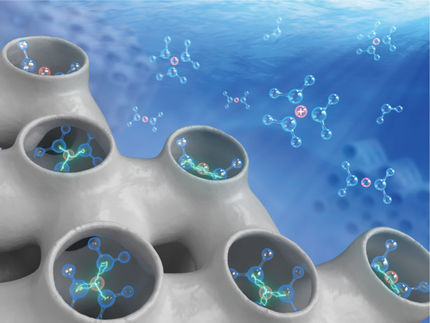Copolymers made of one coil- and one rod-shaped block congregate in giant micelles
Advertisement
The concept of polymers generally brings to mind long, flexible chains of molecules that are tangled like spaghetti on a plate. However, polymers can also have other structures: they can be rigid, branched, or star-shaped; they can have side chains, or can look like tiny combs or bottle brushes. A team of scientists from the Universities of Mainz and Aachen have now successfully synthesized giant "bottle brushes," and have attached them to molecular "spaghetti." In organic solvents, these block copolymers aggregate into gigantic spherical micelles.
When two different types of polymer are coupled together, the product is a block copolymer, which has properties that are completely different from those of either of the individual blocks from which it is made. Of particular interest are block copolymers made of very different blocks-such as flexible, coiled chains and rigid rods. Previously block copolymers of this variety have contained only relatively short rods. Manfred Schmidt, Jun Okuda, and their teams, on the other hand, imagined a molecule with substantially longer rod components. Their approach: the rod could be a brush polymer, a polymer consisting of a long central chain with a very large number of shorter side chains sticking out in all directions, like the bristles of a cylindrical bottle brush. The repulsion between these closely packed "bristles" results in a stretched, relatively stiff polymer conformation. Such brushes can be produced by grafting the bristles onto the central chain. Brushes with precisely defined numbers and distributions of bristles have thus far only been accessible by means of a route that has not met with much success: the individual bristles are added to the chain successively-one at a time. The scientists used a samarium-containing metallocene catalyst to build up relatively long brush polymers bristle by bristle. They then attached one end of these polymers to a "spaghetti" coil. A chemical conversion was then used to change the spaghetti blocks so that they carried a large number of negative charges. This resulted in a block copolymer made of a water-friendly coil and a water-repellant, fat-friendly brush. In the organic solvent tetrahydrofuran, the insoluble coil ends are forced to gather together as tightly as possible, and to let the highly soluble brush ends shield them from the solvent. The polymer thus forms unusually large spherical micelles with a water-friendly core and a fat-friendly shell.
Most read news
Other news from the department science

Get the chemical industry in your inbox
By submitting this form you agree that LUMITOS AG will send you the newsletter(s) selected above by email. Your data will not be passed on to third parties. Your data will be stored and processed in accordance with our data protection regulations. LUMITOS may contact you by email for the purpose of advertising or market and opinion surveys. You can revoke your consent at any time without giving reasons to LUMITOS AG, Ernst-Augustin-Str. 2, 12489 Berlin, Germany or by e-mail at revoke@lumitos.com with effect for the future. In addition, each email contains a link to unsubscribe from the corresponding newsletter.






























































